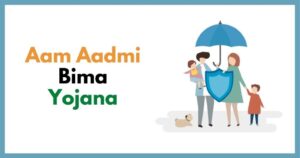Introductione
Aam Aadmi Bima Yojana (AABY), also known as the “Common Man Insurance Scheme,” is the government of India’s primary social security initiative. This programme, which was started with the goal of giving vulnerable groups in society financial support, intends to lessen the sufferings endured by low-income families. We will examine the main features and advantages of the Aam Aadmi Bima Yojana in this blog article, as well as how it is improving the lives of millions of Indians.
Background and Overview
On October 2, 2007, the Aam Aadmi Bima Yojana was introduced as part of the government’s commitment to financial inclusion and social welfare. The Life Insurance Corporation of India (LIC), together with numerous state governments, implements the programme. It primarily targets people who fall below the below-poverty-line (BPL) category as well as other defined occupational categories, including women, rural artisans, and landless labourers.
Key Features and Benefits
The participants enrolled in the Aam Aadmi Bima Yojana are given a thorough insurance cover. Here are some of its main characteristics and advantages:
Life Insurance Coverage: As part of the programme, the family’s major breadwinner is given a Rs. 30,000 life insurance policy in the event of a natural death, an accident, or a permanent disability.
Premium and Subsidy: The central and state governments split the expense of the insurance coverage’s premium amount. By 2023, the annual premium will be Rs 200, of which the government would contribute Rs 100 and the beneficiary will pay the remaining Rs 100.
Children’s Scholarships: The AAMBY also provides educational scholarships for classes 9 through 12 to the insured’s qualified children. Currently, the scholarship is worth Rs. 300 per quarter.
Simple Enrollment Procedure: The programme offers a simple enrollment procedure that enables qualified persons to sign up by providing the required paperwork and paying the small enrollment fee.
Impact and Success Stories
Numerous people across have benefited significantly from the Aam Aadmi Bima Yojana, changing their lives in profound ways. It has helped families deal with unforeseen hardships and emergencies by offering financial protection. The programme has been crucial in boosting social security and financial inclusion among the underprivileged groups in society.
The use of AABY has resulted in numerous success stories. The insurance payout has been made available to families who have lost their main breadwinners, helping them pay for funeral costs, settle debts, and maintain their way of life. The program’s educational grants have given children from underprivileged families the opportunity to pursue their aspirations and get a top-notch education.
Expansion and Reach
The government has implemented a number of initiatives to raise awareness and streamline enrolment in order to expand the scope of AABY. To spread knowledge about the programme in rural and distant locations, efforts have been made to work with local authorities, NGOs, and self-help groups. In order to connect with potential beneficiaries and help them enlist, outreach programmes and mobile camps have also been set up.
Digital initiatives have also helped the program’s expansion. To simplify the registration procedure and offer quick access to scheme information, online portals and mobile applications have been created. The Aam Aadmi Bima Yojana will be implemented more effectively thanks to the tremendous simplification of the enrollment and claim settlement processes brought about by this digital change.
Challenges and Future Scope
The Aam Aadmi Bima Yojana has had some success, but it also confronts certain difficulties. One of the main issues is that the target demographic is unaware of the programme and its advantages. Many eligible people don’t know they are eligible or struggle to complete the enrolling process. To raise awareness and make sure the benefits are received by the intended recipients, ongoing efforts are required.
Settlement of claims on time is another difficulty. In times of stress, the insured people and their families may experience annoyance from the lengthy claim settlement process. To increase the efficacy of the programme and enhance beneficiaries’ overall experiences, the claim settlement procedure must be streamlined and the turnaround time cut.
There is much of room to strengthen the Aam Aadmi Bima Yojana going forward. To keep up with inflation and rising costs, the government should think about raising the insurance coverage threshold. Beneficiaries might also benefit from a more thorough safety net if the potential of optional riders or other coverage alternatives is investigated.
Conclusion
The Aam Aadmi Bima Yojana, which provides financial help and protection to the economically vulnerable segments of society, has grown to be an important social security programme in India. Despite its difficulties, the programme has significantly improved millions of people’s lives by giving them a sense of empowerment and security.
It is critical to maintain a strong focus on awareness campaigns, streamline processes, and improve the overall effectiveness of the programme as the government works to broaden the scheme’s reach and solve its shortcomings. By achieving this, the Aam Admi Bima Yojana can be a symbol of resiliency and hope, helping to improve the socioeconomic conditions of the average person and promoting an inclusive and equal society.
































